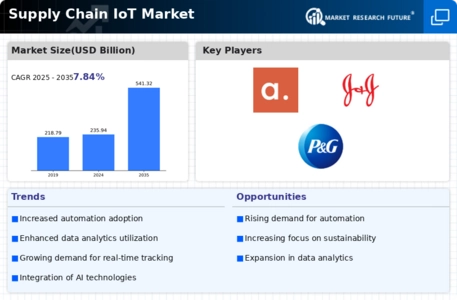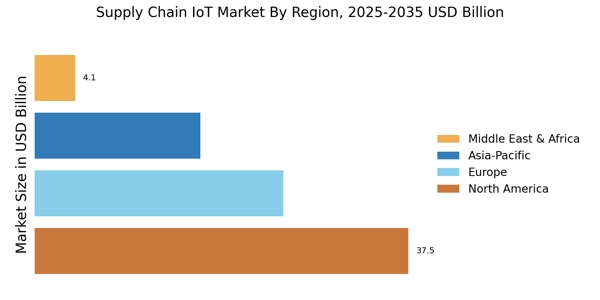Growing Focus on Cost Reduction
Cost reduction remains a primary objective for businesses operating within the Supply Chain IoT Market. Companies are increasingly adopting IoT technologies to streamline operations and minimize expenses. By utilizing IoT devices for inventory management and logistics optimization, organizations can achieve significant cost savings. Reports indicate that businesses implementing IoT solutions can reduce operational costs by approximately 20-25%. This focus on cost efficiency is driving the adoption of IoT technologies, as companies seek to enhance their profitability while maintaining high service levels. The potential for cost reduction is a compelling driver for the growth of the Supply Chain IoT Market.
Increased Consumer Expectations
Consumer expectations are evolving, with a growing demand for faster delivery times and enhanced service quality. This shift is influencing the Supply Chain IoT Market, as companies strive to meet these heightened expectations. IoT technologies enable businesses to optimize their logistics and supply chain processes, thereby improving delivery speed and accuracy. Data suggests that companies utilizing IoT solutions can enhance customer satisfaction rates by up to 40%. As consumer preferences continue to shift towards immediacy and reliability, the adoption of IoT technologies in supply chain management is likely to accelerate, driving further growth in the market.
Integration of Advanced Technologies
The integration of advanced technologies such as artificial intelligence and machine learning with IoT is transforming the Supply Chain IoT Market. These technologies enable predictive analytics, which assists companies in anticipating demand fluctuations and optimizing inventory levels. As per industry reports, the market for AI in supply chain management is projected to grow significantly, potentially reaching USD 10 billion by 2026. This integration not only enhances decision-making processes but also streamlines operations, thereby improving overall supply chain performance. The synergy between IoT and advanced technologies is likely to drive innovation and efficiency in supply chain management.
Regulatory Compliance and Risk Management
Regulatory compliance is becoming increasingly critical in the Supply Chain IoT Market. Companies are required to adhere to various regulations concerning data security, environmental standards, and product safety. The implementation of IoT solutions can facilitate compliance by providing accurate data collection and reporting capabilities. Furthermore, IoT devices can help in risk management by enabling real-time monitoring of supply chain activities, thus identifying potential disruptions before they escalate. As organizations strive to mitigate risks and ensure compliance, the demand for IoT solutions in supply chain management is expected to rise, potentially leading to a more resilient supply chain framework.
Rising Demand for Supply Chain Visibility
The increasing complexity of supply chains has led to a heightened demand for visibility across various stages of the supply chain. Companies are seeking to enhance their operational efficiency and responsiveness by leveraging IoT technologies. The Supply Chain IoT Market is witnessing a surge in the adoption of IoT devices that provide real-time tracking and monitoring capabilities. According to recent data, organizations that implement IoT solutions can achieve up to a 30% reduction in supply chain costs. This trend indicates that businesses are prioritizing transparency and accountability, which are essential for maintaining competitive advantage in a rapidly evolving market.


















Leave a Comment